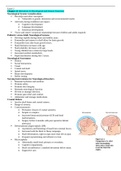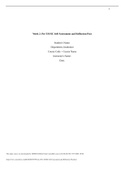Exam 2
Chapter 22 Alterations in Neurological and Sensory Functions
Neurological System Considerations
Develops soon after conception:
o Vulnerable to genetic alterations and environmental insults.
Adversity during childhood can impair:
o Cognitive development
o Language development
o Emotional development
“Serve and return” reciprocal relationship between children and adults required.
Pediatric versus Adult Neurological Systems
Develops rapidly during infant and toddler years.
Fontanelles and sutures in skull allow for brain growth:
Fontanelles fuse after brain growth slows.
Skull thickness increases with age.
Skull pliability decreases with age.
Young children have relatively large heads.
Increased cerebral metabolism.
Rapid myelination during first 3 years.
Neurological Assessment
History
Social Interactions
Visual
Cranial and skull
Spinal nerve
Motor development
Reflex testing
Nursing Interventions for Neurological Disorders
Maintain hydration and nutrition.
Promote safety.
Promote skin integrity.
Maintain neurological function.
Prevent or manage infection.
Promote pain relief and comfort.
Administer and manage medications.
Cranial Defects
Involve skull bones and cranial sutures.
Range of severity.
Craniosynostosis:
o Premature closure of cranial suture(s).
o Simple or complex.
o Increased intracranial pressure (ICP) and head
malformations.
o Surgery before 6 months with post-operative helmet
afterward.
Deformational plagiocephaly (DP):
o Asymmetry and flattening of head from external forces.
o Increased with the Back to Sleep campaign.
o Skull deformation; right occiput more than left occiput.
o Frequent repositioning and orthotics to treat.
Microcephaly:
o Abnormally small head: primary or secondary.
o Cognitive impairments.
o Head circumference 2 standard deviations below mean.
o Supportive care.
,Exam 2
Hydrocephalus
Buildup of cerebrospinal fluid (CSF) in the brain.
Increased CSF production, decreased CSF
absorption, or flow obstruction.
Communicating versus noncommunicating.
Manifestations depend on age and severity:
Dilated scalp veins, bulging fontanel, apnea,
irritability, headaches, and vomiting.
No lumbar punctures if noncommunicating.
Ventriculoperitoneal shunt placement:
o Monitor for infection.
o May need replacement throughout
lifetime as child grows.
o Monitor head circumference to assess
patency.
Intracranial Arteriovenous (AV) Malformations
Rare, congenital vascular lesions.
Asymptomatic at birth.
Most common cause of spontaneous hemorrhage.
Failure of differentiation of vascular channels.
Usually in posterior fossa, basal ganglia, and thalamus.
Symptoms:
o Seizures
o Headaches
o Weakness
o Paralysis
Four-vessel angiography is used to assess and monitor.
Microsurgical resection or endovascular embolization.
Meningitis
Infection of the meninges (membranes protecting the brain).
Aseptic (viral) or septic (bacterial).
Presents with fever, headache, stiff neck, photophobia, and purple rash.
Diagnosed through lumbar puncture, Kernig’s sign, and/or Brudzinski’s sign.
Septic meningitis requires isolation, IV antibiotics, and close neurological monitoring.
Provide those in close contact with prophylactic antibiotics to prevent spreading of illness.
Aseptic meningitis is self-limiting and less severe.
Reye Syndrome
Rapid progression of multiorgan failure with poor outcomes.
Very rare.
Associated with aspirin use during viral illness.
Graded by severity of 0 to 6 based on manifestations.
Collaborative treatment approach in the intensive care unit.
Increased risk of bleeding, ICP management, cerebral edema, increased glucose, and electrolyte abnormalities.
Anticipatory guidance is to avoid aspirin in children younger than 19.
Encephalitis
Infection of meninges with cerebral edema, similar to aseptic meningitis.
Typically viral but can occur from toxins, fungi, bacteria, or parasites.
Usually associated with vector-borne viruses (mosquito).
Increased risk for seizures, flaccid paralysis, headaches, photophobia, lethargy, and stiff neck.
MRI scan is used to identify encephalitic changes.
Treat with IV antibacterial or antiviral medication depending on the cause.
Seizure precautions and close monitoring are necessary
,Exam 2
Seizure Disorders
Electrical disturbances in the brain.
Classified by location and severity,
clinical manifestations, frequency,
duration, or etiology.
Causes motor, sensory, and cognitive
changes.
Some conditions and environmental
factors can increase risk for seizures.
Focal versus generalized seizures (one
or both hemispheres).
Epilepsy
Recurrent, unprovoked seizures.
Considered resolved if no seizure for
10 years or more or has been off
antiepileptic medications for 5 years of
more.
May be an age-related condition.
Diagnostic criteria:
o Two unprovoked seizures more
than 24 hours apart.
o One unprovoked seizure with high probability of repetition over the next 10 years.
Epileptic syndrome present.
Use vagal nerve stimulator if medications are ineffective.
Institute safety interventions during active seizures.
Status Epilepticus
Medical emergency.
Prolonged seizure or series of seizures without recovery in between (more than 5 minutes).
Convulsive or nonconvulsive based on movement activities.
Use IV fluids, oxygen, and IV medications to stop seizure.
Medically-induced coma to stop seizures if necessary.
Febrile Seizures
Acute seizures triggered by high fever in children younger than 7 years of age.
Body temperature greater than 101.2°F (38.4°C).
May also develop epilepsy.
Use encephalogram (EEG) for diagnostic testing.
Self-limiting, but anxiety provoking for parents.
Antiepileptic Medications
Consistency is key to efficacy.
Monotherapy is preferred.
Based on seizure categorization.
Focal (motor onset); generalized (tonic-clonic):
o Carbamazepine (Tegretol)
o Valproic acid (Depakene)
o Phenytoin (Dilantin)
o Phenobarbital (Luminal)
Focal (motor onset):
o Fosphenytoin (Cerebyx)
o Gabapentin (Neurontin)
Generalized (nonmotor onset): Ethosuximide (Zarontin).
Focal (Nonmotor onset): Topiramate (Topamax).
Head Trauma
Traumatic brain injury (TBI) that occurs after a blow or jolt to the head.
Classified as primary or secondary.
Can be accidental or nonaccidental (e.g., shaken baby syndrome [SBS]).
, Exam 2
Infants and toddlers are at greatest risk due to large head.
Manifestations vary based on severity.
SBS is often a silent condition.
Measure cerebral perfusion pressure (CPP) to determine impact of injury.
Assess Glasgow Coma Scale (GSC) score and observe for posturing (decorticate vs. decerebrate).
Monitor for electrolyte abnormalities.
Headaches
Classified as acute, acute recurrent, chronic progressive, or chronic nonprogressive.
Pathophysiology varies based on classification.
Clinical manifestations range from mild to severe.
Monitor for headache red flags.
Treatments vary based on cause:
o Relaxation (most common treatment)
o Over-the-counter medications
o Encourage patients and caregivers to keep a headache journal to determine patterns and causes
Structural and Refractory Disorders of the Eye
Astigmatism:
o Unequal refractory curvatures.
Nystagmus:
o Abnormal movement.
Strabismus:
o “Cross eye.”
o Treat with occlusion therapy.
Infantile glaucoma:
o Increase in intraocular pressure.
Congenital cataracts:
o Cloudiness over corneal lens.
Determine cause of vision disturbances to decide treatment.
Early detection is key; implement regular vision screenings.
Corrective lenses to improve visual acuity.
Nasolacrimal Duct Obstruction
Obstruction of tear duct and excessive tearing.
Failure of canalization of the opening between the nose and nasolacrimal duct.
Red and swollen eyelids; resembles conjunctivitis.
Infection is common because bacteria is not flushed out.
Usually spontaneous resolution within first year of life.
Lacrimal massage and topical antibiotics until open.
Probing with dilation and irrigation if massage ineffective.
Periorbital Cellulitis
Preseptal cellulitis”:
Infection of eyelid and orbital tissues surrounding the eye.
Requires prompt treatment to prevent vision loss and complications (i.e., abscesses, glaucoma, etc.).
Distinct swelling of the eyelid, decreased vision, elevated intraocular pressures.
Methicillin-resistant Staphylococcus aureus should be suspected if there are multiple abscesses.
Hospitalization for IV antibiotics and close monitoring.
Decongestants to decrease secretions.





